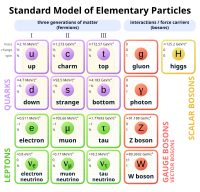
Photo from wikipedia
We demonstrate that all of the salient features of the Harper-Hofstadter model can be implemented with ultracold atoms trapped in a bichromatic ring-shaped lattice. Using realistic sinusoidal lattice potentials rather… Click to show full abstract
We demonstrate that all of the salient features of the Harper-Hofstadter model can be implemented with ultracold atoms trapped in a bichromatic ring-shaped lattice. Using realistic sinusoidal lattice potentials rather than assume the idealized tight-binding picture, we determine the optimal conditions necessary to realize the critical point where the spectrum becomes fractal, and identify the nature and cause of the departures from the discrete model predictions. We also show that even with a commensurate ring with a few lattice sites, the Aubry-Andre localization transition can be realized. Localized states that behave like edge states with energies that reside in the band gaps can be generated by introducing a surprisingly small local perturbation within the ring. Spectrum oscillation arising from complex coupling can be implemented by uniform rotation of the ring, but with certain significant differences that are explained
Journal Title: Physical Review A
Year Published: 2019
Link to full text (if available)
Share on Social Media: Sign Up to like & get
recommendations!